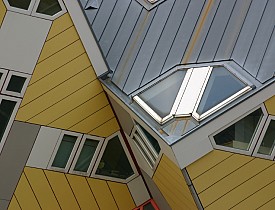Insulating Oddly-Shaped Windows
 New energy-efficient windows may be a good investment in some cases, but oddly shaped windows require custom replacements, which quickly get prohibitively expensive.
New energy-efficient windows may be a good investment in some cases, but oddly shaped windows require custom replacements, which quickly get prohibitively expensive.
Instead, upgrade existing oddly shaped windows to minimize the transfer of heat energy either through the glass or through cracks and gaps in the frame. While insulating shades and other energy-saving measures may not be an option for some oddly shaped windows, you can reinforce existing glass windows, and seal around the frames.
Repair, not replace
For several reasons, repairing old windows may be more eco-conscious than replacing them.
• Older window frames were often manufactured from denser hardwoods, making them more durable and insulating.
• New vinyl windows tend to release toxic byproducts.
• Replacing windows involves all the energy used in creating the new windows, and the landfill space needed for the old windows.
Insulate the glass
Moreover, a well-sealed single-pane window fronted by a properly installed storm window can be more energy-efficient than new double- and triple-pane windows.
Both interior and exterior storm windows increase energy efficiency, but interior windows are easier to add and remove, and they are less likely to trap moisture. Unfortunately, pre-fabricated storm windows are unlikely to fit over oddly-shaped windows, and custom jobs can be expensive.
There is an easy DIY solution -- cut double- and triple-wall polycarbonate panels to fit your window opening and put them up each winter. BuildItSolar.com offers detailed instructions here. The panels are light and sturdy, but easy to cut and highly insulating. The only drawback of multi-wall polycarbonate panels, which are often used in greenhouses, is that they may distort your view, because they have closely spaced ribs holding the panels together.
An even simpler upgrade is clear plastic insulating film. Window insulator kits typically contain sheets of plastic film and rolls of tape for adhering the plastic to window frames. The plastic can be cut into any shape and stretched over windows with a hair dryer.
Like storm windows, the film can be removed at the end of each heating season. Seal around the windows. Next, seal any gaps and cracks around windows. Start by testing for air leaks by holding an incense stick around windows on a cold, windy day. Drafty gaps will force the smoke to be blown in or out of the room.
Caulk and weatherstrip
Caulk any gaps around window frames and add foam or other weather stripping around the moving parts.
Felt weather stripping is among the least effective choices. On the other hand, bronze strips and other metal tension seals can be very effective but difficult to install in less-than-perfect circumstances.
A good option for the bottom edge of double-hung windows or all sides of casement windows is self-adhesive foam. It is flexible enough to install on any window shape, but is relatively inexpensive and effective.
Finally, keep exterior window frames painted to maximize the air seal and prevent rot.
Remember, a little air loss prevents mold growth
Odd window shapes shouldn't prevent energy-efficiency upgrades. But don't go overboard. As with all sealing and weatherization, don't make your home so airtight that you are trapping indoor pollutants and moisture.
Want skilled help in insulating your oddly shaped windows? Find a reliable, professional handyman to tackle the job for you.
Updated May 15, 2018.
Looking for a Pro? Call us (866) 441-6648

Average Costs
Related Experiences

Deck Repair On A Deadline

The Power Of Multiple HVAC Estimates



